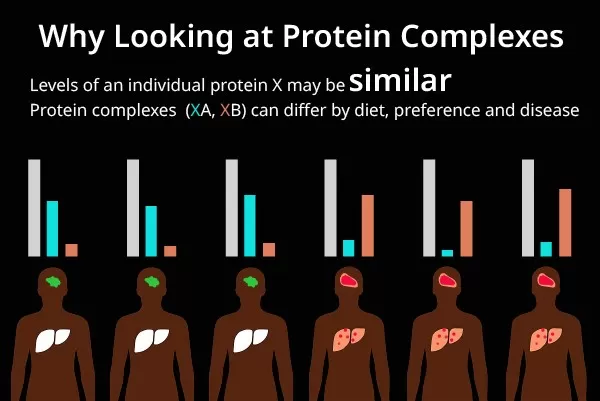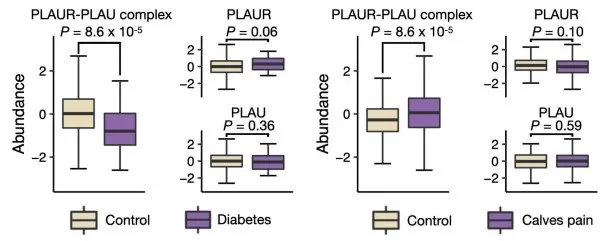Protein Complexes: What They Are and Why They Matter in Biomedical Research
What Is a Protein Complex?
 A protein complex is a group of two or more proteins that physically interact to perform a specific biological function. Unlike single proteins, complexes work as integrated molecular machines. Each subunit brings unique activity or stability, making the whole complex functionally greater than the sum of its parts. These assemblies are essential in processes like DNA replication, signal transduction, and metabolism. When scientists refer to 'complex proteins', they often mean these multi-protein structures rather than just proteins with complex sequences. Understanding what a protein complex is helps interpret how proteins work in real biological systems. With the rise of high-throughput proteomics platforms like Olink and SomaScan, analyzing protein complexes offers deeper insights than looking at single proteins alone.
A protein complex is a group of two or more proteins that physically interact to perform a specific biological function. Unlike single proteins, complexes work as integrated molecular machines. Each subunit brings unique activity or stability, making the whole complex functionally greater than the sum of its parts. These assemblies are essential in processes like DNA replication, signal transduction, and metabolism. When scientists refer to 'complex proteins', they often mean these multi-protein structures rather than just proteins with complex sequences. Understanding what a protein complex is helps interpret how proteins work in real biological systems. With the rise of high-throughput proteomics platforms like Olink and SomaScan, analyzing protein complexes offers deeper insights than looking at single proteins alone.
Why Looking at Protein Complexes Matters More Than Individual Proteins
Even when the levels of an individual protein remain relatively stable across different individuals or conditions, the composition and balance of the complexes it forms can vary significantly — and those differences often carry critical biological meaning.
As the diagram illustrates, the same amount of protein X can be found in various people, but whether protein X assembles into complex XA or complex XB differs depending on factors like diet preference or disease state. This suggests that functional insight comes not just from measuring proteins individually, but from understanding how they assemble and interact.
In biomedical research and precision medicine, this means looking at protein complexes provides a higher-resolution view of biological processes, offering more specific biomarkers and actionable targets than protein-level analysis alone.

Same Protein, Different Complexes – Why Functional Context Matters
Types of Protein Complexes
Protein complexes can be classified based on composition and stability. The table below summarizes the major types:
|
Type |
Description |
Example |
|
Homomeric Complexes |
Composed of identical subunits |
Actin filaments, homodimeric enzymes |
|
Heteromeric Complexes |
Made of different protein subunits |
G-protein complex, RNA polymerase |
|
Obligate Complexes |
Subunits are stably associated and typically not functional alone |
Ribosome, proteasome |
|
Transient Complexes |
Form temporarily in response to stimuli or during reactions |
JAK-STAT signaling complex |
Among these, transient complexes are particularly important in signaling cascades, assembling only when a stimulus is present.
Structure of Protein Complexes and Notable Examples
Protein complexes vary in size and shape depending on their function. The following table highlights some well-known examples:
|
Protein Complex |
Function |
Structure Highlights |
|
Hemoglobin |
Oxygen transport in red blood cells |
Tetramer (2 alpha, 2 beta chains) |
|
DNA Polymerase Complex |
DNA replication |
Multi-subunit enzymatic machinery |
|
Proteasome |
Protein degradation |
Barrel-like core with regulatory subunits |
|
ATP Synthase (Complex V) |
Cellular energy production |
Rotor-like structure with membrane-embedded components |
|
Electron Transport Chain |
Mitochondrial respiration |
Series of 4 large complexes (I–IV) + ATP Synthase (V) |
These examples show how structural complexity enables specialized functions, which is why studying protein complexes is central to modern biology.
Functional Role of Protein Complexes in Biology
Why do protein complexes matter? They enable functional synergy. Proteins within a complex can work together to regulate cellular processes with higher specificity and efficiency. These complexes are often tightly controlled — their formation can act as a biological switch. For example, signaling cascades rely on assembling and disassembling complexes rapidly. Importantly, proteins in a complex tend to show co-expression and co-regulation, making them useful for data-driven analysis. In modern systems biology, thinking in terms of networks and complexes provides more actionable insights than focusing on individual proteins. That’s why many protein complex-related keywords appear in today’s omics and disease research trends.
Protein Complexes and Disease Biomarker Discovery
Complexes as Biomarkers
A protein complex may serve as a more specific disease indicator than single proteins. Traditionally, biomarkers rely on the level of individual proteins. However, complexes often reflect the functional state of a biological process. Detecting the presence or imbalance of a complex, or failure of its subunits to assemble, can be more informative than single protein changes. For example, one study on PTSD found that a specific complex remained persistently elevated in affected patients, suggesting its potential as a blood-based biomarker.
Disease Mechanisms Involving Complexes
Many genetic and degenerative diseases involve malfunctioning protein complexes. Mutations in a single subunit can impair the entire complex. For example, certain types of cardiomyopathy are caused by mutations in mitochondrial electron transport chain complexes, disrupting energy production. Neurodegenerative diseases like Alzheimer’s also involve pathological protein aggregation, altering normal complex dynamics.
Case Highlight: Protein Complex PLAUR–PLAU as a Disease Biomarker
In a study involving over 1,000 individuals, researchers found that while the levels of individual proteins PLAUR and PLAU were similar across groups, their assembled complex showed a significant difference in abundance between healthy controls and patients with type 2 diabetes or leg pain (P = 8.6×10⁻⁵). This finding highlights the power of protein complex analysis: changes that are invisible at the single-protein level can become clearly detectable when assessing complex formation. It underscores why analyzing protein complexes provides a more functionally meaningful readout in biomarker discovery.

The PLAUR–PLAU complex exhibits disease-associated abundance differences, whereas individual PLAUR or PLAU proteins do not show statistical significance.
Protein Complexes as Drug Targets
Protein complexes are emerging as strategic drug targets. Instead of inhibiting a single enzyme, modern drugs may disrupt the interface or prevent assembly of entire complexes. For instance, targeting the mTOR complex or BCR-ABL fusion complex has proven effective in cancer treatment. This approach leverages the dependency of disease cells on specific protein assemblies.
Multi-Protein Biomarker Signatures
With high-throughput proteomics, researchers often use panels of proteins for disease classification. These panels frequently include subunits of the same complex or pathway. For example, inflammation biomarkers may involve several cytokine or complement complex components. Co-detection improves specificity and reflects real biological mechanisms.
Summary: Role of Protein Complexes in Disease Research
|
Role |
Examples |
Significance |
|
Biomarkers |
PTSD-related complex elevated in blood |
Functional readouts beyond individual proteins |
|
Mechanism Elucidation |
ETC complex mutations in cardiomyopathy |
Link between complex loss and disease phenotype |
|
Drug Targets |
mTOR and BCR-ABL targeted in cancer therapy |
Complex inhibition or stabilization as a treatment strategy |
|
Proteomic Signatures |
Cytokine complex components in inflammation panels |
Improves confidence in diagnosis and interpretation |
MetwareBio Helps You Perform Protein Complex Analysis on Olink & SomaScan Data
Have you already collected Olink or SomaScan proteomics data? Don’t stop at individual protein hits. Let MetwareBio help you extract deeper insights by identifying co-regulated protein complexes, mapping them using databases like CORUM and STRING, and uncovering their roles in disease or treatment response. Our expert team combines statistical modeling, network analysis, and biological interpretation to pinpoint meaningful complexes from your high-throughput data. Whether you're exploring disease biomarkers or drug mechanisms, understanding the protein complex landscape can transform your findings. Contact us to get a free consultation and learn how to power your discovery with protein complex analysis.
FAQs about Protein Complexes
Q1: What is a protein complex?
A protein complex is a group of two or more proteins that physically interact to perform a specific biological task. These complexes are essential in processes such as signal transduction, metabolism, and DNA replication.
Q2: How are protein complexes different from complex proteins?
The term “complex protein” can refer to either a single protein with a complicated structure or, more precisely in biochemistry, a multi-subunit protein complex. In this article, "protein complex" means multiple proteins functioning together.
Q3: What are some well-known examples of protein complexes?
Examples include the ribosome (for protein synthesis), ATP synthase (for energy production), the proteasome (for protein degradation), and Complex I–V in the mitochondrial electron transport chain.
Q4: Why are protein complexes important in disease research?
Protein complexes often reflect functional biological states. Disruption or abnormal formation of a complex can signal disease, making them useful biomarkers or drug targets in conditions like cancer, neurodegeneration, and heart disease.
Q5: How can I analyze protein complexes from Olink or SomaScan data?
You can analyze protein complexes by detecting co-expressed proteins, mapping them to known complexes using databases like CORUM or STRING, and identifying functional clusters.
MetwareBio offers expert protein complex analysis from high-throughput proteomic datasets.
Next-Generation Omics Solutions:
Proteomics & Metabolomics
Ready to get started? Submit your inquiry or contact us at support-global@metwarebio.com.


